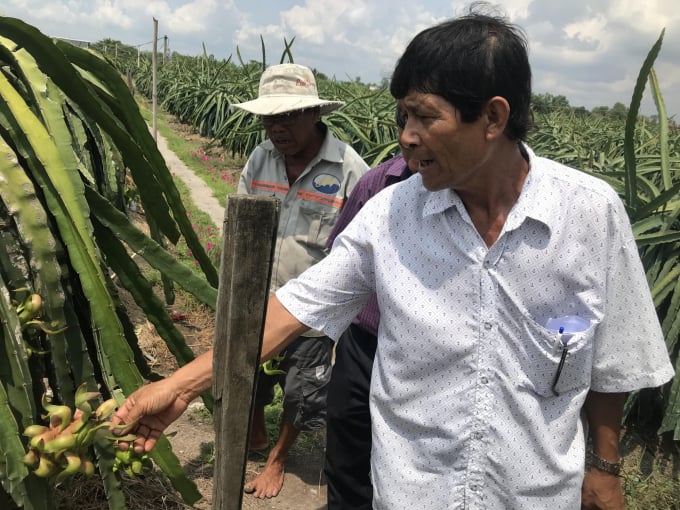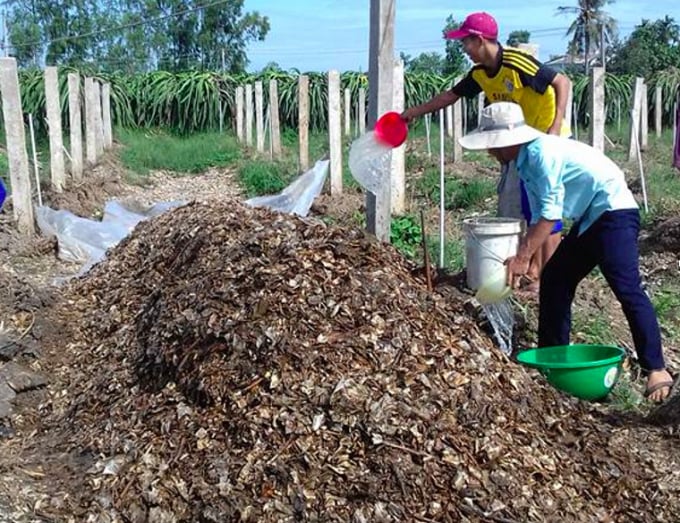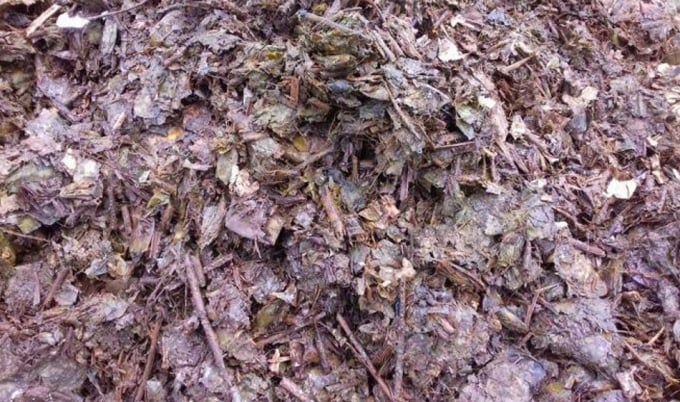May 30, 2025 | 07:55 GMT +7
May 30, 2025 | 07:55 GMT +7
Hotline: 0913.378.918
May 30, 2025 | 07:55 GMT +7
Hotline: 0913.378.918
Dragon fruit is one of the main crops of farmers in Binh Thuan, Long An and Tien Giang.
During the caring process, when the dragon fruit tree reaches the age of 4 years or more, useless branches and sheaths appear and need to be removed. Farmers grow 1,200 - 1,300 pillars of dragon fruits per ha, therefore the amount of branches that require removal each year is approximately 12-15 tons.

Tien Giang province has over 9,000 ha of land growing dragon fruits. Photo: Minh Dam.
In order to resolve this matter as well as sustainably develop dragon fruit trees, the Microbiology Laboratory, Southern Horticultural Research Institute has carried out the topic: "Research on the treatment of discarded dragon fruit branches using beneficial microorganisms combined with manure to produce bio-organic fertilizers". From the research results, the Institute's scientists have come up with a recommended process so that farmers can effectively utilize this type of waste.
Dr. Nguyen Thi Ngoc Truc, deputy head of the Department of Agronomy, Southern Horticultural Research Institute, said, "Not treating the pruned dragon fruit branches may unintentionally cause environmental pollution as well as facilitate the spread of pathogens. Therefore taking advantage of beneficial microorganisms can help decompose dragon fruit branches into organic matter (decompose cellulose in cells), destroy pathogens, provide nutrients for the dragon fruit trees and the soil at the same time.”
Cellulose is the most stable and abundant organic compound in nature. Every year on earth, about one hundred billion tons of cellulose are synthesized. It is an inexhaustible source of energy for the development of society. One of the development directions of cellulose is to break it down into D-glucose (Zakazia Ahmed et al., 2001).
In order to effectively execute this process, the Southern Horticultural Research Institute has introduced the three steps of composting dragon fruit stems and branches into bio-organic fertilizer.
Step 1: Cut off and collect old and diseased dragon fruit branches
Regularly check, cut down and collect dragon fruit branches with symptoms of white spot disease and many dark, fast-spreading lesions.
Prune periodically or after each harvest to remove ineffective, ailing branches that are unable to bear fruit or produce unsatisfactory fruit.
Collect to the gathering point (the incubation yard - 1 to 2 gathering points depending on the orchard area). Cover the compost pile with tarpaulin to avoid spreading pathogens if not treated immediately.
Note: the composting yard of dragon fruit branches needs to be isolated from the water source for irrigation to avoid the water source being contaminated with the water from the compost pile.

Mix chopped dragon fruit branches with probiotics. Photo: TL.
Step 2: Process dragon fruit branches
Chop dragon fruit branches into pieces of 3-5cm each (farmers can use dragon fruit chopping machines or chop manually).
For the first week, incubate with lime with a dosage of about 5 kg for 1 ton of dragon fruit branches. Lime has the effect of disinfecting, killing pathogens in the branches. Farmers pile up 500 - 1,000kg of dragon fruit branches each.
Later cover them with canvas. During this process the temperature of the compost pile will rise to about 65 - 70 degrees which also contributes to the elimination of pathogens.
After one week, open the canvas and mix with bacteria that degrade cellulose in dragon fruit stem cells. Farmers use 15kg of Bacillus subtillis VL33 for 1 ton of dragon fruit branches. This product needs to be diluted with water on a 1:1 ratio, then sprayed evenly on the compost pile.
Cover the compost pile with tarpaulin to prevent rain and sun and maintain moisture. The incubation period is approximately two weeks.
Next, treat white spot pathogens with Lactobacillus Plantarum CC6 after two weeks of dragon fruit branches with incubation VL33. Farmers use 15kg of CC6 for a 1-ton pile of dragon fruit branches.
Dilute CC6 with water on a 1:1 ratio, spray evenly on the compost pile, mix well and continue to have them covered with canvas for two weeks.
Finally, incubate and add nitrogen fixing and phosphate solubilizing bacteria Burkholderia Tropica (BT).
At this stage, farmers use 10kg of BT diluted with water on a 1:1 ratio, spray evenly on the four-week-old pile of decomposed dragon fruit.
Continue to cover with tarpaulin and incubate for one week in order to help beneficial bacteria (nitrogen fixing and phosphorus solubilizing) adapt and multiply in the compost pile.

Bio-organic fertilizer from sua dragon fruit branches when composting. Photo: TL.
Step 3: Use microbial organic fertilizer after composting from dragon fruit branches
To use it effectively, farmers mix the decomposed dragon fruit branches with rotten manure with the ratio of dragon fruit branches/manure being 2:1. Continue to cover with canvas and incubate for one week.
Microbiological organic fertilizers made from rotten dragon fruit branches can be re-fertilized for dragon fruit gardens, provide organic nutrients and beneficial microorganisms to the soil, and reduce the cost of chemical fertilizers.
Fertilize method: Apply 30 kg of rotten dragon fruit branches to one dragon fruit pillar, use hay or straw to cover the base to help organic fertilizer work better.
Cellulose-degrading microbial biomass multiplication
In order to have 15l of microorganisms with less money, farmers just need to buy 1 kg of Trichoderma or Bacillus subtillis (commercially available) for biomass multiplication.
Formula: 100l of water and 3% sugar incubated within 5 days to get 100 liters of microorganisms.
With 100l of microorganisms, only 15l is needed for 1 ton of dragon fruit branches to decompose cellulose.
Translated by Samuel Pham
/2025/05/25/4127-3-073637_820.jpg)
(VAN) Thanks to the promotion from an FAO-implemented project, vegetable production in greenhouses in Moc Chau has seen strong development, from 1.5 hectares in 2021 to nearly 50 hectares in 2024.

(VAN) FAO has recently supported USD 140,000 to implement the project 'Risk mitigation human-animal interface risks through disease control initiatives in pig farming.'

(VAN) The People's Committee of Tra Vinh province has approved an adjustment to the investment policy for the Green Hydrogen Plant project, increasing its area to approximately 52.76 hectares.
![Reducing emissions from rice fields: [2] Farmers’ commitment to the soil](https://t.ex-cdn.com/nongnghiepmoitruong.vn/608w/files/news/2025/05/05/dsc08881jpg-nongnghiep-140632.jpg)
(VAN) Clean rice cultivation model in Thuong Tan commune, Bac Tan Uyen district, is assisting local residents in achieving sustainable agriculture by substantially reducing costs, increasing productivity, and protecting the environment.

(VAN) At the conference to disseminate Resolution No. 68, AgriS introduced its digital agricultural ecosystem and reaffirmed its commitment to accompanying the Government in promoting private sector development and sustainable agriculture.

(VAN) 'Blue Ocean - Blue Foods' initiative is designed to restore marine ecosystems and establish sustainable livelihoods for local communities by cultivating a minimum of 1,000 hectares of cottonii seaweed in the first three years.
/2025/05/21/4642-3-112707_603.jpg)
(VAN) The V-SCOPE project has made direct contributions to three out of six pillars of the Comprehensive Strategic Partnership between Vietnam and Australia.